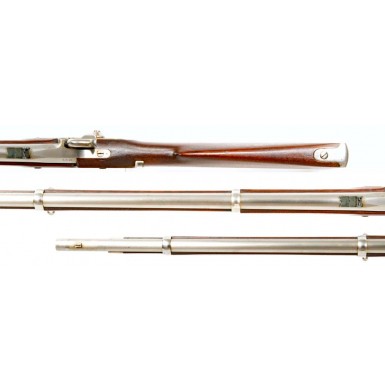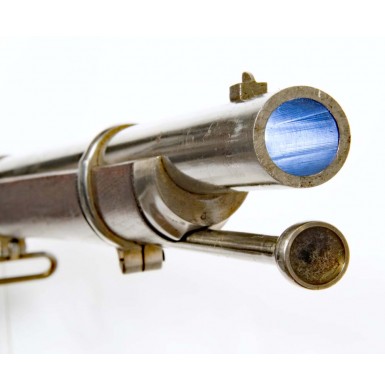Excellent Colt M1861 Special Model Rifle Musket
- Product Code: FLA-3509-SOLD
- Availability: Out Of Stock
-
$1.00
The story of the origin of the Special Model 1861 Rifle Musket as designed by Samuel Colt and produced by The Colt Patent Firearms Company, Lamson, Goodnow & Yale and Amoskeag, is one of the more interesting stories in Civil War firearms manufacturing. The story starts nearly a decade before the American Civil War with the British involvement in the Crimean War, which started in 1854. With a huge and sudden demand for the newly adopted Pattern 1853 Enfield rifle musket, the British looked to makers outside of England to produce the additional guns that they needed. One of the companies they turned to was Robbins & Lawrence, a firm that had been mass producing firearms on the principle of interchangeable parts for some time. Robbins & Lawrence had also been involved with the manufacture and installation of the gun making equipment at the Royal Small Arms Factory at Enfield Lock. These experiences made the firm particularly qualified to produce Enfield rifle muskets for the British, so Robbins & Lawrence was granted a contract to produce 25,000 Pattern 1853 Enfield rifle muskets. At the same time, the ever industrious Sam Colt was in the process of setting up his gun making facility in London and approached the British government with an offer to produce fully-interchangeable Enfield rifle muskets at a mere $7.50 each! That was less than half of what the Board of Ordnance was currently paying for contractor-produced muskets that were not made with interchangeable parts. The caveat to Colt’s offer was that the contract had to be for one million guns! The British Board of Ordnance rejected the offer, and it was a good thing for Colt. The war in the Crimea ended much sooner than expected, and the British cancelled all of their outstanding orders for Enfields that had been placed with non-English contractors. This resulted in Robbins & Lawrence, who had spent a significant amount of money on machinery and tooling to produce Enfields (and who had only delivered about half of the initial order of 25,000), filing for bankruptcy and having their assets sold at auction. Gun manufacturers like Lamson, Goodnow & Yale (LG&Y), Colt and Whitney descended on the auction and bought machinery, tooling and already fabricated gun parts for pennies on the dollar. This placed these companies in particularly good positions to vie for US Government contracts with the coming of the American Civil War. When the war commenced, Colt immediately approached the US War Department with an offer to manufacture as many 500,000 rifle muskets per year. While Colt’s production estimates were certainly optimistic, his company was known for quality and mass production. After some wrangling, Colt secured an initial contract for “25,000 muskets of the exact pattern now being made at the United States armory at Springfield”. Colt actually had no intention of producing exact replicas of the US M1861 “Springfield”, but rather a somewhat simplified design of his own that outwardly resembled the M1861, but inwardly was much more akin to the Enfield and could use many of the parts, machinery and tooling which had been acquired by the various makers at the Robbins & Lawrence auction. In June of 1861, Colt’s chief designer approached Erskine S Allin, the Master Armorer at the Springfield Arsenal with his design for what would be eventually be known as the US M1861 “Special Model” Rifle Musket, and between the two of them the first sample musket was produced and forwarded to Colt to use as a pattern gun. The gun incorporated screw fastened clamping barrel bands (like the Enfield) instead of solid bands that were retained by springs. There were mechanical changes in the lock to make it more “Enfield-like” internally, and the more direct breech vent eliminated the need for a clean out screw as was necessary for the 90-degree turn found in the bolster of the Springfield design. The one improvement of Root’s that most impressed Allin were modifications to the M1858 pattern rear sight that was due to be used on the M1861 muskets. First, Root designed the sight base walls to be higher, which protected the 100 and 300-yard sight blades when they were lying flat. He also recessed the head of the tension screw that the sight blades pivoted on, which protected the screw from damage. Finally, he squared off the tops of the sight leaves and deepened the notches. This made the sight leaves easier to move and adjust with a fingernail and made the sight picture clearer. Allin was sufficiently impressed with these improvements that the Root designed M1861 rear sight was adopted in July of 1861 and replaced the M1858 rear sight on the M1861 Rifle Muskets produced at Springfield. The new pattern sight was also specified for subsequent contractor produced guns. Thus the Special Model 1861 Rifle Musket was born. Over the next three years, Colt, LG&Y and Amoskeag would produce more than 185,000 of these guns for US government and several state contracts. 177,026 of these guns were delivered to the US Ordnance Department. With Colt delivering 100,005 between 1862 and 1864, LG&Y delivering 50,020 during the same period and Amoskeag delivering 27,001 between 1863 and 1865. Many of the design changes and manufacturing improvements included in the “Special Model” would become standard features on the US M1863 Springfield Rifle Musket, when the M1861 was redesigned at the arsenal in that year.
The Colt Special Model 1861 offered here is in about EXCELLENT condition overall. The lock is clearly marked in three horizontal lines forward of the lock: U.S. / COLT’S PT F. A. MFG Co / HARTFORD, CT and is dated 1863 behind the hammer. The upper left barrel flat is crisply and deeply marked with the usual US V / P / Eagle Head proof marks, and the matching date 1863 is stamped on the top of the breech. The left side barrel flat is crisply marked with the inspector initials E.F. The majority of Colt produced barrels are marked STEEL on the flat near the breech, but not all of them. This one is, as would be expected. The barrel is also correctly marked with a Csub-inspection mark on the top of the breech plug tang. The bolster is clearly marked with a US “Spread Winged Eagle”, which remains crisp and clear. In typical Colt fashion, the metal parts are marked with a plethora of small sub inspectors marks, including the C on the barrel tang, a T at the front and an C at the rear of the triggerguard plate, an M on the triggerguard, and a clear US on the buttplate tang along with an J sub-inspector’s mark. The rear sight base is marked with a C. All of the barrel bands bear the usual U mark for “up” on the obverse and are sub-inspected as well. The upper barrel band is marked with a T, with the middle and lower band marked with an M. The stock also shows inspector marks, with a small M.M.J forward of the buttplate tang and with two excellent US inspector cartouches on the flat opposite the lock; a script DAP (Dwight A. Perkins) a script JT (John Taylor). Both cartouches are within rectangular boxes with rounded edges. The gun is extremely crisp throughout and very well marked, with all marks remaining clear and sharp. The gun is 100% complete, correct and original in every way. The lock plate is bright and shiny with very clear markings and shows only some light discoloration from old oil and some freckles of light surface oxidation. The lock functions perfectly and remains extremely crisp and tight on all positions. The metal of the barrel is mostly bright, with some dulling towards pewter due to age. There is some minor scuffing around the muzzle where a bayonet has been on and off the gun over the years. The barrel shows some scattered areas of minor discoloration due to old oil discoloration. It appears the entire gun was covered with a thin coat of linseed oil long ago, and most of this was subsequently cleaned off but leaving some residue in the nooks and crannies. The metal also shows some minor, lightly freckled age discoloration and oxidation. The barrel is quite smooth and is free of pitting. The bore is in bright, EXCELLENT condition as well, and retains strong, crisp rifling. The balance of the bright metal furniture matches the condition and patina of the barrel perfectly. The original multi-left rear sight is present and retains about 90%+ original, bright blued finish on the base and a similar amount of bright blue on the sight leaves. The original sling swivels are present as well on the triggerguard bow and the middle barrel band. The original, full-length, straight-shank, tulip head rammer is present as well and retains perfect threads on the end. The ramrod is sub-inspected with an L near the tip. The stock is full-length, solid and free of any cracks or repairs. The stock is extremely crisp and sharp and even retains much of the original feathery texture to the wood. The edges are extremely sharp and there is no evidence that the stock has ever been sanded. As would be expected, it shows a handful of minor bumps, dings and minor surface scrapes from storage, handling and use over the past 150 years. The only stock condition issue worth pointing out is a short, narrow scrape, about 1 ½” long near the bottom of the obverse butt stock. This is minor and in no way detracts from the display of this extremely crisp and very high condition Colt musket, but it is mentioned for exactness. As would be expected from any Colt firearm, the stock displays and retains excellent wood to metal fit throughout.
Overall this is an exceptionally attractive and truly fantastic condition example of one of the most desirable contract guns used by the US military during the American Civil War. Every collection of Civil War long arms needs to have a “Special Model 1861” rifle musket in it and this is one is very attractive, and 100% original and complete. Any collector would be proud to have this wonderful musket in their long arms collection, and it would be nearly impossible to upgrade the condition without finding one in “new” condition in the original shipping crate.
SOLD















